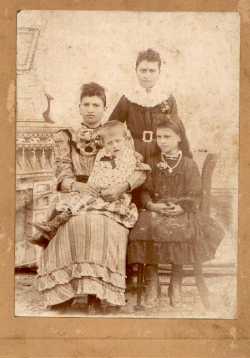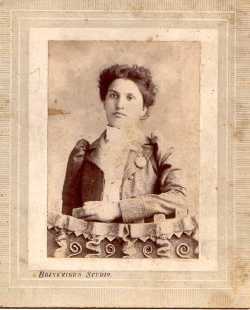Sign up for the Family Tree Newsletter Plus, you’ll receive our 10 Essential Genealogy Research Forms PDF as a special thank you!
Get Your Free Genealogy Forms
"*" indicates required fields

Photo 1
Photo 2
Photograph collections are usually a mix of identified and mystery images. Sitting in your unidentified pile may be another picture with a younger or older version of the person in your identified pile. Facial clues in those images can help you date those picture puzzles if you know what to look for. Age, illness, weight gain or loss, injury and, in men’s cases, facial hair or baldness can change a person’s appearance.
Lee Eddy submitted this photograph (Photo 1). She felt one of the girls in the picture was her grandmother, born in 1890, but wanted confirmation of this tentative identification. To help, Lee sent me a couple of additional photographs. She saw a resemblance between the woman in the single portrait and a woman in the group portrait but wanted another opinion. Let’s see how the two images work together.
There are several striking clothing features in this photograph of three girls and a boy. The girl standing in the back is wearing a large white collar over her dress. This was a style worn by young girls from the late 1870s into the late 1880s. The younger of the seated girls is wearing a heavy gold necklace as an accessory. Jewelry of this type was popular in the 1870s. No single costume clue provides a definite date for the image; rather, it is the context of the two photographs that helps provide a time frame for the first image. Dresses of the style worn in the group portrait seem to place it in the period 1878-1883. When there is a lack of specific datable items, it helps to look at hairstyles. In this case, the older girls are wearing their hair pulled back with tightly curled bangs on the forehead. This detail firmly places the photograph at the end of the estimated time frame.
When you closely examine the first photograph do you notice anything unusual? There is grass under the girl’s feet. This picture was taken outdoors with a backdrop and a few props. In order to take photographs, photographers needed light. Flash photography wasn’t introduced until 1884. Take a look at the children’s faces. Each of them is trying not to squint from the sunlight. The youngest child is not able to completely control his face and the squint is more noticeable. Either this picture was taken outside to take advantage of good light or a traveling photographer took it. Itinerant photographers traveled through rural areas taking pictures along the way. They could set up a fancy backdrop or a plain sheet, a few chairs and if they posed individuals in a particular way, no one could tell the picture was taken outdoors.
This second portrait (Photo 2) is of a well-dressed woman taken circa 1891. The sleeves of her suit have vertical puffs at the shoulder seams. Within a few years these puffs lack the vertical height and instead are full around the upper arm. So if you know when one image was taken it helps you date the other image.
The woman in the single portrait is probably the same woman who is holding the child in the first picture. Why? When comparing facial features it is important to look carefully at noses, eyes, facial shape and ears. According to the family, Lee’s grandmother was of Cherokee descent. Her facial features and expression are very similar to the other woman. Understanding how individuals age in a particular family can help you estimate how old people are in portrait. In the group portrait, the woman appears to be a teenager, but may in fact be a young adult. If this is the case, then the woman may be Lee Eddy’s great-grandmother born in 1855 instead of her grandmother, who wasn’t born until 1890.
ADVERTISEMENT


